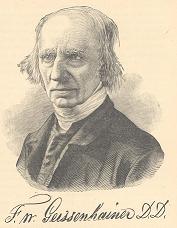from History of Queens County with illustrations, Portraits & Sketches of Prominent Families and Individuals.
W.W. Munsell & Company, 1882
Rev. Dr. Frederick William Geissenhainer was born in New Hanover, Montgomery county, Pa., June 28th 1797. His father was Rev. Dr. Frederick William Geissenhainer, a native of Prussia (whence he came in 1793) an early Lutheran minister in America and a man of remarkable literary and theological attainments, distinguished for his intelligence and particularly noted for his thorough scholarship in Hebrew, Latin and Greek, and as a profound mathematician, mineralogist and botanist of extensive scientific acquirements.
The history of the iron and coal interests of Pennsylvania and the world pictures him as a character of importance in the infancy of those interests, with an influence upon their subsequent development which will be felt to the end of time. He was the first to discover the value of anthracite coal for smelting iron, and his name is prominently identified with other important discoveries which have for years been a portion of the recognized system of iron manufacture. For a number of years he officiated as pastor of Christ Lutheran church, in Frankfort street, New York, which was distinguished as being the only church in New York besides the Episcopalian which escaped desecration at the hands of the English, it being attended by the Hessian soldiers, who were Lutherans. The senior Dr. Geissenhainer died in 1838.
The subject of the present notice came to New York with his father at an early age, and received a thorough academical and theological education under the able preceptorship of his father and instructors whom the latter employed.
In 1818, when he was only twenty years of age, he was licensed as a minister of the Lutheran church. He was first settled over a congregation at Vincent, Chester county, Pa., where he remained ten years, when he was called to the pastorate of St. Matthew’s church in Walker street, New York, in which he continued about fourteen years. The congregation of Christ church after a time became the possessors of the property of St. Matthew’s congregation and took the name of the latter organization. In pursuance of a resolve to found a new church, Dr. Geissenhainer established St. Paul’s, of which he was pastor until his death, June 2nd 1879. The first preaching was in a hall in Eighth avenue. A church was built in 1842, at the corner of Sixth avenue and Fifteenth street, chiefly through the liberality of Dr. Geissenhainer himself. It is a fine stone structure and the valuation of the property now reaches $80,000. Dr. Geissenhainer organized St. Paul’s church with eleven poor families. The congregation now has about 1,300 communicants and the Sunday-school has a membership of over 600 scholars.
Through Dr. Geissenhainer’s efforts, and largely at his own personal cost, the Lutheran Cemetery at Middle Village was established, it being his design to open a place of sepulture where graves would be sold at such low prices as to render them obtainable by people of limited means, who were often taxed far beyond their ability to pay by the managers of other cemeteries. So entirely feasible was Dr. Geissenhainer’s plan, and so good his management of the affairs of the cemetery (now in the hands of his son F.W. Geissenhainer, the present treasurer), that the annual interments in the Lutheran Cemetery outnumber those in any other Protestant cemetery in the United States. This cemetery was opened in 1850 and incorporated March 22nd 1852.
Dr. Geissenhainer married Mary, daughter of Boltis Moore, of New York city, September 6th 1824. Three of their children- Frederick W., Mary L. (now Mrs. Hunter) and Jacob A.- are living. Boltis, another son died at the age of two years, in 1827.
A portrait of Dr. Geissenhainer accompanies this article. He was of about the medium height, sparely made, and even in his old age possessed a great amount of activity. It will be observed that his head was more long than round in its contour, with features of the German type, small and regularly moulded. His eyes were lit with a keen, often merry twinkle. He was a person of much vivacity and
cheerfulness, and his conversational powers were such as to render him a most agreeable social companion, while his manners were not only courteous, but so kindly and unassuming that a stranger found himself on the best terms with him in the shortest possible time. He talked upon any subject with interest, knowledge and animation, and showed himself at once the profound scholar and thinker, the shrewd observer of passing events, and the genial, open hearted gentleman. He preached an original and very practical sermon, and was a pointed, logical writer, and while he came very directly to the idea he wished to convey, his argument in maintaining every position was absolute and overwhelming. He dealt mostly with themes which invited a learned exposition of the Scriptures and of the moral obligations which are incumbent upon mankind. His people sought and obtained of him practical religious and moral instruction, given with the authority of a man holding a sacred commission to proclaim the truth, and with the tender concern of a father solicitous for their temporal and spiritual welfare. He had a clear, distinct voice and was emphatic in his manner of delivery, and equally acceptable as a speaker in the English and German languages, having them both at his command. There was an ever present dignity and seriousness about him in the pulpit, and everything he did was in evident recognition of the sacredness of the place and occasion and the responsibility resting upon himself as a teacher.



